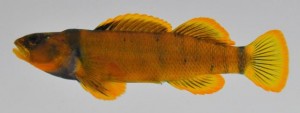Since 2010 I have been visiting the last series of rapids in Little Beaver Creek in eastern Ohio just before that stream flattens out to the pool level of the Ohio River and joins it. This particular site is interesting because it lies near the junction of Ohio, PA, and WV and is a high quality stream in terms of habitat and water quality. In the past 2-3 decades we have witnessed the re-expansion of several rare or water quality sensitive fish species in the upper Ohio River basin. Much of this expansion appears to have started in the Allegheny River basin in PA and Little Beaver Creek represents the first system in Ohio that may be a place expansion of such species from PA can be witnessed in Ohio.
I first visited that location on a hunch that the (at the time) state threatened Bluebreast Darter (Etheostoma camurum) might be present in the area. That fish was de-listed in 2012 because its expansion here and other places in Ohio was so great.
I had attempted to use the more conventional sampling method of kick seining for this species in that area, but because of the abundance of very large rocks, it did not work. I decided to try to snorkel there in the Autumn, when the water is often at its lowest and clearest. Given the temperature of the water (upper 50’s), I had to wear a a full body wet suit in order to use that observation method.
On that first trip on October 1st 2010, I observed Bluebreast Darters within 5 minutes of starting the snorkeling observations. That was the first record of the species in that location and the first for the whole river basin of more than a single individual caught in 1998 by Ohio EPA. Our team, two colleagues and I, snorkeled for 5 hours that first trip and also saw the state threatened Tippecanoe Darter (Etheostoma tippecanoe) for the first time ever in that river system.
- Bluebreast Darter, Etheostoma camurum, female
- Bluebreast Darter, Etheostoma camurum, male
- Tippecanoe Darter, Etheostoma tippecanoe, female
- Tippecanoe Darter, Etheostoma tippecanoe, male
Since then I have made this an annual trip near the end of September or early October. I have also made observations by seining and other methods further up this stream system. In 2010 we only saw the Bluebreast Darter at the lower end of the ~100 yard series of rapids. To date I have found them as far as 12 miles upstream in Little Beaver Creek and they are now very common in that last series of rapids. They are also fairly common in the lower 6-7 miles of the stream in most riffles. I have also seen the Tippecanoe Darter increase in numbers some but not as dramatically. In 2015 I found a single Tippecanoe Darter each 2 miles and 4 miles upstream from that location.
I have also observed other new species for the basin. In 2014 I found Streamline Chub (Erimystax dissimilis) for the first time ever and Bigeye Chub (Hybopsis amblops) for the first time in nearly 50 years in that river system. This year was no exception as far as finding new species. I once again observed both darters mentioned above and both chubs were more abundant than last year. In addition to these, I observed the first state endangered Gilt Darter (Percina evides) ever found in a tributary to the Ohio River in Ohio. This species was thought to be entirely extirpated from Ohio, having only been found prior to 1900 in the Ohio River and Maumee River. None were seen in Ohio at all for over 100 years until it was rediscovered in 2010 in the Ohio River near Gallipolis, OH by an environmental consulting company. After this first individual, I found 13 more in the Ohio River over the past several years, but this 14th (15th overall since rediscovery) specimen was the first not in the Ohio River itself. Also this year I observed two Channel Darters (Percina copelandi), also a state threatened species, that is a little more common in the Ohio River main channel.
- Streamline Chub , Erimystax dissimilis
- Bigeye Chub, Hybopsis amblops
- Gilt Darter, Percina evides, female
- Gilt Darter, Percina evides, male
- Channel Darters, Percina copelandi
All of these new observations make me want to return each year to see what I may come across next. It is exciting to witness first hand the re-expansion of these once very rare fish into new places. This is the overall trend with moderate to large river fish species in Ohio. And now the smaller, less mobile species of fish are also moving and colonizing new areas. The general consensus is that this is the result of the Clean Water Act from 1972, plus other regulations and efforts to clean and protect our waterways. It took more than 40 years for us to observe the impact of these conservation efforts in the fish population of Ohio rivers.
About the Author: Brian Zimmerman is Research Associate at the ‘Stream and River Ecology (STRIVE) Lab’ in the School of Environment and Natural Resources & Field Collections Coordinator in the ‘Fishes of Ohio Inventory and Distribution Project’ of the Fish Division.










